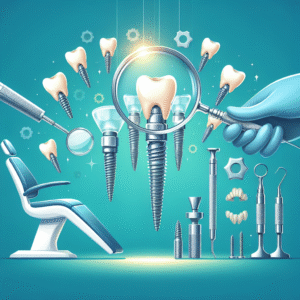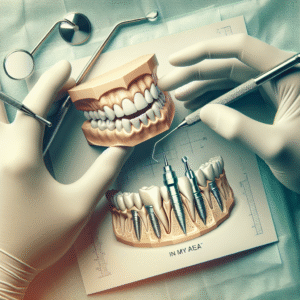Introduction to All-on-4 Dental Implants
The All-on-4 dental implant procedure represents a significant advancement in implant dentistry, particularly for patients with edentulous jaws. Unlike traditional dental implants, which often require a separate implant for each missing tooth, the All-on-4 technique strategically places four implants in the jaw to support a full arch of replacement teeth. This innovative approach allows for greater stability and functionality while minimizing the need for complex surgical procedures or bone grafts.
This method has gained popularity due to its numerous advantages. One of the primary benefits of All-on-4 implants is the reduced healing time. Patients can often receive a temporary set of teeth on the same day as the surgery, allowing for immediate restoration of function and aesthetics. Additionally, All-on-4 implants provide a more cost-effective solution compared to traditional implants, as fewer implants are needed while still achieving a natural appearance and feel.
Candidates for the All-on-4 procedure typically include individuals who have lost most or all of their teeth and are seeking a long-term solution. Ideal candidates often struggle with discomfort from removable dentures or face difficulties with chewing and speaking. Furthermore, the All-on-4 system is particularly appealing for patients who may have experienced bone loss in the jaw, as the technique can often negate the requirement for bone grafting procedures. The strategic positioning of the implants allows them to be anchored into areas of the jaw that have adequate bone density, enhancing the overall success of the treatment.
In summary, the All-on-4 dental implant procedure offers a compelling solution to the challenges faced by those with missing teeth. Its unique methodology, coupled with its increasing acceptance among qualified candidates, underscores its role as an effective alternative to traditional dental treatments.
Factors Influencing the Cost of All-on-4 Implants
The All-on-4 dental implant procedure is a popular solution for individuals who require complete arch rehabilitation. However, the cost associated with this treatment can vary significantly based on several key factors. Understanding these elements can provide prospective patients with a clearer picture of their potential financial commitment.
One of the primary determinants of cost is geographic location. Dental practices situated in metropolitan areas often charge higher fees than those located in smaller towns or rural settings. This variation is primarily due to differences in the cost of living and operating expenses incurred by the practice. As such, individuals in high-cost urban environments may find the All-on-4 procedure less accessible. Conversely, patients in more affordable regions may benefit from lower overall expenses.
The experience and reputation of the dentist performing the procedure also play a significant role in establishing costs. Highly experienced practitioners and those with specialized training in implantology often charge premium rates for their services. Patients might consider this an investment in quality, as a skilled dentist is likely to achieve more favorable outcomes, enhancing the longevity and success of the implants.
Additionally, the type of materials used in the All-on-4 implants can influence the total price. For example, titanium implants, while more expensive, are favored for their strength and biocompatibility. Furthermore, the choice of prosthetic teeth, whether they are made from acrylic or porcelain, can impact costs. Patients should discuss with their dentist the materials that best meet their needs and budget.
Lastly, any necessary additional procedures, such as bone grafting or sinus lifts, can further increase the total cost of the All-on-4 dental implant process. These procedures might be essential for individuals with significant bone loss, as they provide the structural support needed for successful implant placement.
Average Cost Breakdown by Region
The All-on-4 dental implant procedure has emerged as a popular solution for those seeking a secure and stable alternative to dentures. However, the costs associated with this treatment can vary significantly depending on the region, making it essential for prospective patients to understand what to expect financially.
In the United States, for instance, the average cost of the All-on-4 procedure typically ranges between $20,000 to $30,000. This price can fluctuate depending on the location, with urban areas like New York or Los Angeles often experiencing higher costs due to increased overhead and demand for advanced dental services. In contrast, rural areas may offer more competitive prices, potentially lowering the total cost to around $15,000 to $25,000.
Across different countries, costs also display considerable variation. In Canada, the All-on-4 procedure may cost between CAD 17,000 and CAD 30,000, which translates roughly to US dollars depending on the current exchange rate. Meanwhile, patients in European countries, such as Germany or the United Kingdom, can expect to pay between €15,000 and €25,000. In some developing nations, prices can be substantially lower, with the All-on-4 procedure potentially costing as little as $10,000, attracting patients seeking affordable dental care abroad.
Moreover, it’s crucial to consider additional factors that influence these costs, including the dentist’s experience, the materials used for the implants, and any pre-operative or post-operative care required. Patients are encouraged to research thoroughly and obtain multiple estimates before deciding on a treatment provider. By understanding these regional price differences, individuals can make informed decisions regarding their dental health options.
Potential Additional Costs Associated with All-on-4 Implants
The All-on-4 dental implant procedure is often praised for its efficiency and effectiveness in replacing missing teeth. However, potential patients must be aware that there can be several additional costs associated with the process that may not be immediately obvious. Understanding these costs is essential for those aiming to budget effectively for their dental care.
One of the primary expenses that patients often overlook is the pre-surgical consultation. This initial visit is critical for assessing the patient’s oral health and determining the best plan for the implants. During this consultation, diagnostic imaging, such as X-rays or 3D scans, may be required, adding to the overall cost.
Another significant factor to consider is sedation dentistry fees. While many patients may opt for sedation to reduce anxiety during the procedure, this convenience often incurs an additional charge. The type of sedation chosen, whether it’s local anesthesia or more extensive options like IV sedation, can vary the costs considerably.
Follow-up appointments are also an essential aspect of the All-on-4 implant process. Regular check-ups are crucial for ensuring the implants are healing correctly and functioning as intended. These appointments, while necessary for long-term success, can accumulate additional costs that patients should plan for in their budget.
Lastly, it’s important to account for the maintenance costs of the implants. This includes not only routine dental hygiene appointments but also any potential repairs or replacements that may be required over time. Understanding these potential expenses will provide a clearer picture for budgeting, allowing patients to approach the All-on-4 dental implant procedure with informed financial decisions.
Insurance Coverage and Financing Options for All-on-4 Implants
The All-on-4 dental implant procedure has emerged as a revolutionary solution for individuals seeking to replace an entire arch of teeth. As the procedure can be quite costly, understanding insurance coverage options is crucial for potential patients. Generally, dental insurance plans vary significantly in their coverage of dental implants. Some plans may cover a portion of the All-on-4 procedure, while others may not include any benefits related to implant surgeries at all. It is advisable for patients to carefully review their insurance policy or consult with their insurance representative to determine the extent of coverage provided. Patients should also inquire about any prerequisites that must be met before receiving approval for their insurance claims regarding this specific procedure.
In many cases, dental insurance policies typically categorize implant procedures under prosthetics. Consequently, coverage may depend on the specific details outlined in the policy. For instance, if a patient has a plan that covers dentures, they might be eligible for coverage of the All-on-4 implants as an alternative treatment. However, limitations and maximum benefits may apply, impacting the total out-of-pocket expenses incurred.
In addition to insurance coverage, various financing options exist to assist patients in managing the costs associated with All-on-4 dental implants. Many dental practices offer payment plans that enable patients to pay for their treatment over time, reducing the immediate financial burden. Moreover, dental loans, which are specifically designed for such procedures, offer a practical solution for individuals who wish to spread out the payments. These loans typically come with fixed interest rates and repayment terms that can accommodate different budgets. By exploring both insurance coverage and financing options, patients can make informed decisions and effectively manage the costs associated with obtaining All-on-4 implants.
Comparing All-on-4 Implants to Other Dental Restoration Options
The All-on-4 dental implant procedure has gained prominence for its efficient and effective restoration of dental function, especially for patients seeking an alternative to traditional dentures. When considering the cost-effectiveness and long-term benefits of All-on-4 implants, it is crucial to compare them with other dental restoration methods such as traditional dentures and various implant systems. Traditional dentures are non-invasive and typically have a lower initial cost compared to dental implants. However, dentures often require adjustments and replacements over time, leading to additional expenses that can accumulate significantly. Moreover, they can result in discomfort and may affect the quality of life due to limitations in chewing and speech. They also do not provide the same level of stability as dental implants, which can impact both function and aesthetic appearance.
On the other hand, when evaluating other types of implants, the All-on-4 method stands out due to its unique design and implant placement strategy. Conventional implants may require multiple surgeries, a lengthy healing process, and substantial bone grafting, which can increase both the treatment time and overall costs. In contrast, All-on-4 implants utilize just four strategically placed implants to support an entire arch of teeth, often eliminating the need for additional bone grafting and significantly reducing surgery time and recovery. This efficiency translates to lower overall costs when factoring in the long-term benefits.
Financially, while the upfront investment for All-on-4 implants may appear higher than that of traditional dentures, the durability and longevity of implants often make them the more economical choice in the long run. Patients may find that they experience fewer complications and lower maintenance costs with All-on-4 implants, which contribute to a better quality of life. This comparison underscores the importance of considering not just the initial cost but the long-term value and benefits that All-on-4 dental implants can offer over other restoration options.
Long-term Costs vs. Short-term Costs of All-on-4 Implants
The All-on-4 dental implant procedure provides a comprehensive solution for patients requiring full arch replacement. When assessing the financial implications of this treatment, it is essential to differentiate between short-term and long-term costs. The initial investment for All-on-4 implants can be substantial, often encompassing expenses related to consultation, surgical procedures, materials, and the creation of custom prosthetics. Typically, patients might find themselves facing these significant up-front costs, which can be a deciding factor in opting for this treatment.
However, a deeper analysis reveals that the longevity and durability of All-on-4 implants can mitigate these initial expenditures significantly. Unlike traditional dentures, which may need frequent replacements and adjustments, All-on-4 implants are designed for an extended lifespan, often exceeding ten years with proper care. The materials used in this procedure, such as titanium for the implants and high-quality dental acrylic for the prosthetics, contribute to their resilience against daily wear and tear.
Additionally, the maintenance costs associated with All-on-4 implants tend to be lower in comparison to other restorative options. Routine dental visits for check-ups and cleanings may be necessary, but they are seldom as frequent or costly as those required for dentures. Hence, while the upfront costs of All-on-4 implants may be considerable, their long-term value emerges from reduced replacement frequency and lower ongoing maintenance expenses. The initial investment can be viewed as a gateway to greater savings over the years, ultimately offering patients a more cost-effective and durable solution for their dental needs.
Patient Testimonials and Experiences with All-on-4 Implants
The All-on-4 dental implant procedure has transformed the lives of many patients, providing not only a functional solution for missing teeth but also enhancing their overall quality of life. Numerous testimonials showcase the financial implications associated with the treatment, point to the emotional relief experienced post-procedure, and highlight the confidence regained through a restored smile.
One patient, Kenneth, shared his journey stating, “Before my All-on-4 implants, I struggled with self-esteem issues due to my missing teeth. The financial investment was substantial, but the results far outweighed the costs. Now, I enjoy eating out with friends and no longer feel embarrassed to smile.” Kenneth’s experience demonstrates how investing in such implants can lead to significant emotional and social benefits, reinforcing the value of the procedure beyond just the monetary aspect.
Another patient, Maria, reflected on her apprehensions about the procedure, saying, “I was initially worried about the financial burden of the implants, but after consulting with my dental team, I realized there were flexible payment plans available. The procedure itself was less painful than I imagined, and within a few months, I felt like a new person.” Maria’s testimony emphasizes the importance of understanding payment options, as well as recognizing the long-term advantages of All-on-4 implants.
Moreover, John, who underwent the same treatment, noted a transformative impact on his lifestyle: “I feel like I’ve gotten my life back. Eating is no longer a painful experience; I indulge in foods I hadn’t touched in years.” His account illustrates not just the functional improvements but also how such enhancements positively influence daily living.
Overall, the feedback from patients underscores that while the All-on-4 dental implant procedure requires a significant financial commitment, the emotional and psychological rewards it brings are invaluable, leading to happier, more fulfilled lives.
Conclusion: Making an Informed Decision About All-on-4 Implants
In navigating the complexities of dental health, the All-on-4 implant procedure presents a viable solution for those seeking to replace missing teeth effectively. Throughout this discussion, we have emphasized the significance of understanding both the costs and benefits associated with this dental restoration method. The All-on-4 system offers a unique benefit by supporting an entire arch of prosthetic teeth on just four strategically placed implants. This not only simplifies the surgical process but also reduces recovery time, making it an appealing option for many patients.
Importantly, the financial investment involved in this procedure should be analyzed from multiple perspectives. While the initial costs might seem high, potential long-term advantages such as improved oral health, enhanced functionality, and increased self-esteem can ultimately justify the expense. Moreover, considering factors like durability and the reduced likelihood of needing future dental work can influence an individual’s perception of cost-effectiveness regarding All-on-4 implants.
Before proceeding with such a significant decision, it is paramount for individuals to consult with experienced dental professionals specializing in implantology. They can provide personalized assessments, elaborate on various financing and payment options, and help patients weigh their personal circumstances against the benefits and costs discussed. A thorough understanding of one’s specific dental and financial situation is essential in making an informed choice regarding All-on-4 implants.
Ultimately, investing time for research and professional guidance can lead to a rewarding experience, restoring not only one’s smile but also improving quality of life. Therefore, careful consideration of every aspect involved in the All-on-4 dental implant procedure can facilitate a decision that meets both clinical and personal needs effectively.




